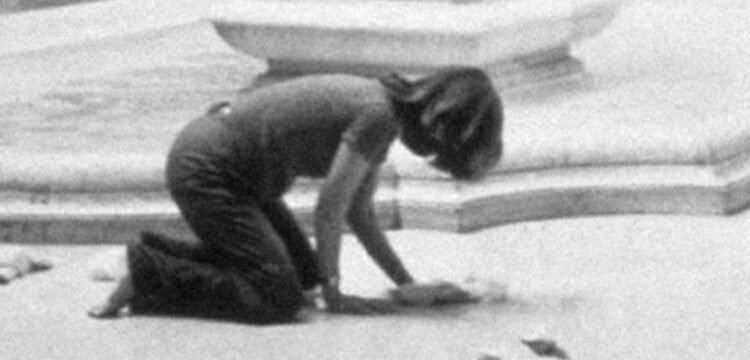She Was Not Supposed To Be Loud
But she screamed at the right time: a conversation with Selma Selman
Selma Selman is an artist, activist, and educator. Coming from Bosnia and Herzegovina, from a family of Romani origin, she challenges the art world’s unspoken rules and bias by questioning the reasons behind curators’ invitations to international shows. Through her artistic practice, she consciously subverts the values assigned to objects and people by the current neoliberal socio-economic system, using museums and galleries as a framework capable of elevating cheap, overexploited, manual labor to the elite status of artworks. While developing more complex procedures to achieve this, she has recently drawn together extra-disciplinary collaborations with science-related experts to extract gold from technological waste. Having at the center of her interests the emancipation of oppressed groups, in particular of Romani women of all ages, she understands her artistic practice in terms of the applications and disruptive effects that it can reach by expanding its scope beyond the art world.
EARLY LIFE AND CAREER
Giulia Menegale: You were a 17-year-old young woman working as a commercial artist in your Bosnian hometown, Bihać, when you involved all your family members in the production of artworks which, at that time, were mainly commissioned paintings. How has your artistic practice changed since then?
Selma Selman: I was doing landscapes, portraits, and copying the great masters you can find in any Art History book. If you see those paintings now, you would not believe they were mine. I had my first serious solo show around that time. The deal with the local gallery was something similar to €1000 to make this show, and I accepted, thinking—“Ok, let’s see what I can do.” It was a 30 square meters gallery that used to organize cultural events and did not look like a commercial space. After that, all of a sudden, the boom happened. I was in newspapers, magazines, and everyone started to buy my work. At that time, I made an agreement with my father. He would have been my manager, sell the artworks and share the money with the family. This is how we managed to survive for many years, but I had to produce a lot of paintings. I was doing between five to ten commissions a day. My entire family started painting with me since it was far too much work for one person. I was giving instructions, and they were executing the paintings. My sisters and, sometimes, my mother posed as my models. After finishing high school, I went to Banja Luka, another city in Bosnia, to join a BA program at the Academy of Arts in the Department of Painting. I stayed there for four years, and during that period, I began researching further, doing more, and conceptualizing political work. When I turned 24, I received a grant to move to New York and start an MFA in Transmedia Visual and Performing Arts at Syracuse University, New York.
Were you still focusing on painting during your university degree?
It was painting and, sometimes, doing something else. Since I was always financially unstable as any other art student, I was using bed sheets that my mother gave me to paint. I can show a photo of my canvases. There are only a few traces of them left. Can you see them?
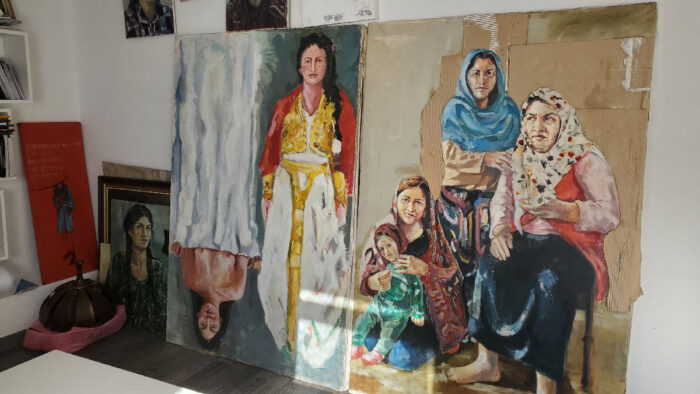
Yes, I can see them. The one on the left looks like a family portrait, while the one on the right has two women depicted on it. One of them is lying naked and upside down on a bed. She is half-covered with a blanket. The woman next to her dresses in traditional Balkan wedding clothes.
The painting on the left is a family portrait. It is a collage made out of different fabrics and papers. The other on the right is my own interpretation of two historical oil paintings by the Spanish Romantic painter Francisco Goya. These are La maja vestida (The Clothed Maja),1800–1805, and the earlier La maja desnuda (The Naked Maja), 1797–1800. The women in my paintings refer back to the two “Maja” from Goya: the “Maja” who is a sinner, and the “Maja” who is a traditional woman. The latter one, the “Maja” who does all she is supposed to do, is my sister when she got married. I am the woman half naked and ashamed. I was embarrassing my family because I did not want to get married.
Shortly after, you conceived the performance You have no idea [Vi Nemate Pojma] (2016–2022). There are different versions of this piece, but I remember vividly the video documentation I saw at Manifesta 14, at the National Gallery of Kosovo in Prishtina last year.
You know when you feel the pressure of creating coming from the outside? Then, you start creating impressions of your life and the life around you. I conceived this performance when I was in my 3rd or 4th year at the Academy. The video documentation you saw at Manifesta 14 is from 2020. In that version, I am walking from the Black Lives Matters Plaza to the White House building on U.S. Election Day and screaming the same sentence—“You have no idea”. Sometimes, the piece lasts longer; other times, it is shorter. It depends on the general energy that surrounds me. The shortest version of the performance I did was in Sarajevo, at the National Gallery of Bosnia and Herzegovina in 2021. It lasted 5 minutes. Suddenly, it felt like—“I can not anymore.” Other times, it resulted in an hour and a half of constant screaming. The performance conveys a straightforward message and can talk to many of us. This is why I still like that piece a lot.
“You do not know who I am, nor do you know my happiness or sadness. You do not know about the presence or absence of pain in my life, nor how I feel at the moment that I perform this piece to a live audience. You have no idea!” [1] In brief, this is your message for the people passing by on the streets and for us who are watching the performance from the sterilized environment of the white cube.
Yes, this is the description of what I think while performing. All can understand this performance. People get emotional and attached to these words because I say almost nothing, but I say everything.
It is a very impactful performance. I can hear anger in your voice when you spell these words. They make me reflect on emotion’s role in social and activist movements. If mobilized critically, anger signals that something around you is wrong. It can be an effective tool for social change.
It can be perceived as anger but also as “resistance” and “protection”. I am never trying to defend myself by denying who I am. This is the strategy I have applied all my life and in my work. In my works, I constantly confront my audience with the disorientation I provoke when my voice gets heard, and tells the truth. According to a patriarchal world and the place I am coming from, I was not supposed to be loud as a woman, as a minority, as a Roma, as anyone. This is why I represent a danger to society now. I can be “the most dangerous woman in the world“ if you want me to be. This is also the title I gave to one of my solo shows from 2022. [2]
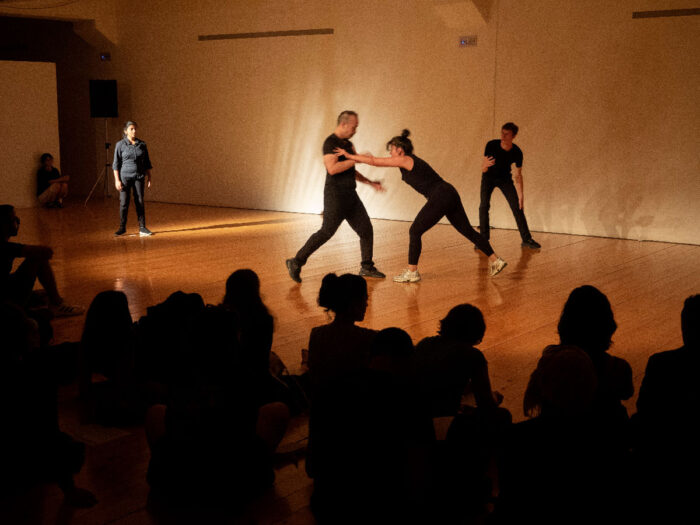
ON FREEING IDENTITY FROM ESSENTIALISMS
A relevant part of your artistic research looks at how you face the effects and pressures of having conflicting identities. You have been working on this issue since 2017, starting from Superposition, a piece where you are wearing boxing gloves to attack, defend and coach yourself simultaneously. At that time, the performance reflected your experience of having dual nationality, and living as an immigrant in the US. Why is the scientific concept of superimposition interesting to you?
There are studies in quantum physics that prove that quantum atoms are traveling everywhere at the same time in multiple directions. This phenomenon is called superimposition theory, and it provides a beautiful explanation for how I feel about identity, especially when I am in a context that wants me to show “Roma art”. By translating this theory into visual forms, I am creating a position where I can be anything at the same time. We are all bubbles full of identities and never one; this is what I am trying to explain to people in a visual manner. The series of drawings on paper, Superpositional Intersectionalism (2019–ongoing), which came after the performance you just mentioned, came out from the period when I started to intensively explore this theme. These drawings are full of bodies that are constantly stretching and transforming. Now, I have begun painting similar shapes on the car parts. For me, the car’s speed and the Universe’s speed connect. In both cases, you never see who is who, “who is white and who is black.” It is a clash where all our bodies become one.
Recently, Superpositional Intersectionalism (2023) became a piece performed with your art partner Chongha Peter Lee at Centrale Fies Festival, in Italy. How does a two-person fight contribute to your visual research on the superposition theorem?
I came up with the idea of presenting the superposition theory to the audience in real terms. My partner and I enacted a 10-minute “fight”. We were struggling and trying to defend ourselves against each other as in a boxing match. In addition to that, a person was communicating to the audience how far we had traveled through the galaxy, and how many times we had changed roles, genders, species and names. Another person was commenting on the match at the same speed the galaxy is moving through the universe—speaking one word per kilometer that the galaxy travels—producing a tone that cycles 600 times per second.
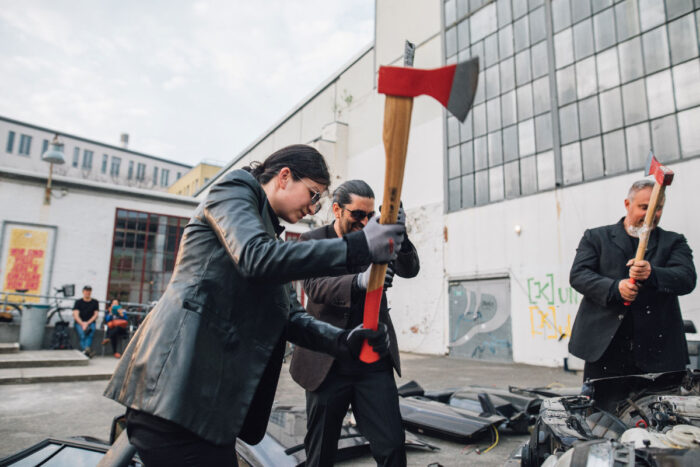
ON TRANSFORMING VALUE
Through your work, the audience learns that capitalist society assigns different values to people and objects. This happens for the profit of an elite. How does your work intervene in these dynamics?
The best verb to describe my work is neither performance, drawing, or painting. It is transforming. I am a “transformer,” which also feels hilarious because the term has a very masculine connotation. For a consistent time now, I have been challenging the art world with a series of long-term art projects on labor. I am interested in the labor of minorities and the unprivileged. Take, for example, Mercedes Matrix, 2019. It is a collective piece, originally performed at the Krass Kampnagel festival in Hamburg, Germany. My family and I dismantled a Mercedes-Benz car to recycle its parts. We re-enacted my family’s day-to-day job but in an art context. This manual labor, that they are performing daily in the scrapyard, becomes privileged within the art world. I always ask the institution to pay all of us the same and, in the end, we all manage to get paid equally. The car pieces I am recycling are the same in our village, but now they have become artwork and, as such, they get a place in museum collections worldwide.
You often collaborate with the male members of your family: your father, brother, and neighbors from the village.
Yes, I collaborate a lot, especially with my father. He always has excellent ideas. When I receive important invitations, I usually organize meetings with my family members to discuss what we should do next. Of course, they are not involved in all my artworks, but we consult each other for some. This is a beautiful practice because it is a way to make them feel included in the job that they know to do professionally. When my family and I deal with sizable objects, we do not just destroy them. We do surgery on them. You need expert eyes for this kind of work because not everybody can smash a car so that its parts can still be useful for something else. If you want to avoid ending up with chaos, it is fundamental to select and handle the parts carefully.
I want to return to this idea of transformation, which is hugely present in your works, especially in the recent art projects where you are matching art and science together. How do you use art to turn metal wreckage into something still valuable for society?
There are many layers in my work, as I said, but everything means to be transformative, actual, and accurate. For example, for Motherboards (2023–ongoing), the project I realized within my period of residency at Rijksakademie, Amsterdam, in the Netherlands, I have been researching how to extract gold from disused computers’ Central Processing Units (CPU) in a non-toxic manner. This research took me two years. When we saw these graveyards of technological remains, nobody could have imagined they would someday acquire life. Now, I discovered a technique that only the chemical engineer who helped me and I know; we can obtain a patent right to it. This is a crucial project for me because it has many applications beyond art.
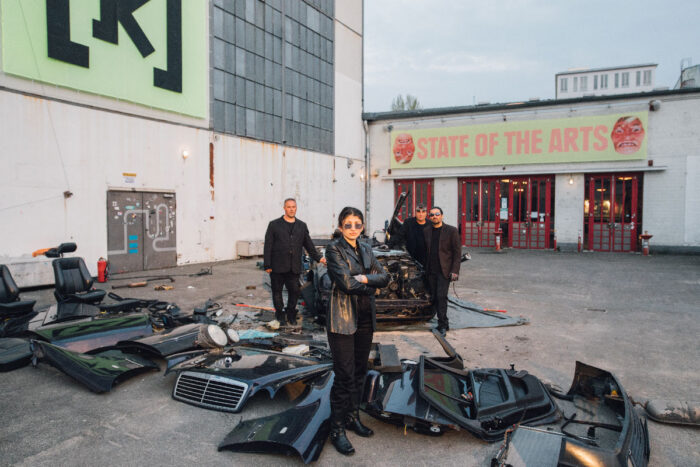
What object have you realized from the extracted gold?
I made the golden nail which I drilled into the wall of the Rijksakademie, for the open studios. This object is the only thing that stands there, in the art space. This choice suggests the project has nothing to do with art or creativity. In the end, what you observe is the actual labor. When I think about the kind of labor of recycling gold that is happening in many undeveloped countries, I hope this process can help in those areas where kids are recycling precious metals with their bare hands while being exposed to heavy liquids and chemicals. But for whom are these children doing the labor, if not for white people? I do not want my art to be part of that. Gold itself is problematic because it is an object of desire, causing suffering and inequalities worldwide. At the moment, I only have plans for opening a Lab in my hometown in the next two years, where the process will benefit people from my community.
Since 2017, you have personally financed and directed the program “Marš u školu” / “Get the Heck back to school” through a foundation you established to support the education of Roma girls in your hometown Bihać. Will this project also be part of your activist engagement?
All my artistic projects are also “activist” because they are always about human conditions. I have works that are purely statements, but most serve societal changes. For me, that is what art is about. Art should always bring something. Of course, art should also be just like a painting on the wall. When I was younger, I was also doing these beautiful paintings to be hung on the wall. Now, my world is entirely different, and I am trying to make these changes effective and evident, even on the quantum level. And believe me, slow transformations are happening. Take my biography and all the support I receive from people who know my work, for example. No one ever expected that I would have done all these things. I am 32 now, and I have experienced a lot. I do not want people to pass through all the challenges I had but, at the same time, they have defined my strength.
Your relationship with the art world interests me. I have the impression that you use the art world, intended as a system with consistent inequalities, built on market-driven relationships and intense competition within the attention economy, for your own great scopes.
I am not supposed to say that. You said that. Especially today, you have artists who enjoy fame. They hang out with all these celebrities and are all into fashion. They are more fashion models than artists themselves. Fashion and art are brands. So, what do you have to do as an artist who understands art as something to push for societal changes? You must play with that. Someone says, “Let yourself be manipulated while you are manipulating.” But sometimes, when I see all these artists who enjoy fame and how many followers they have on Instagram, with whom they hang out, to whom they sell their paintings, and how much their worth is costing, I think that art is just like pop culture. Something that Andy Warhol was trying to do, and he literally succeeded in it. He manufactured art. But at the same time, when you think about Banksy, he was the real deal. He was faster than Andy Warhol, even though Andy Warhol had machineries. So, it is not only about being famous, and it is not only about selling. Sometimes it is also about doing some small things that bring you something you can share with others. As an artist, you have to survive, right? So you need to be part of the art scene to get the funding, to sell your work because that is what you need, that is your work, and that is what you know how to do. I’m very happy that I can live out of my art.
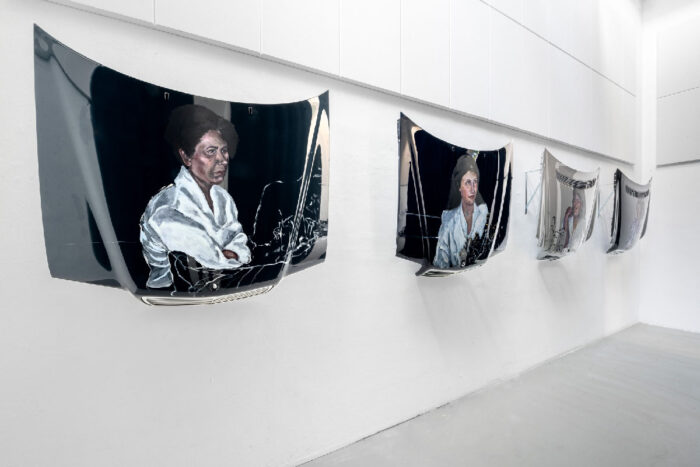
If it is true that we live in a society that assigns arbitrary values both to people and objects, your work restores dignity to individuals and bodies that have suffered oppression and devaluation throughout their lives. In The First Wedding, 2023, the new series of portraits on Mercedes car hoods, recently shown at the fourth edition Autostrada Biennale, in Prizren, Kosovo, curated by Övül Ö. Durmuşoğlu and Joanna Warsza, you have represented the women in your family, never as victims, but rather as heroes.
Victimization is something that the art world often wants from you. They want you to be presented as a victim. They want you to do victimization. I usually do the opposite of that. When I make the work, I never think about the institution where it will be presented; I create it because I find it necessary. These portraits come from that urgency. They are from family pictures taken in the 90s, during one of the first large Roma weddings after the war. I know these women personally, and one of them is my mother. The portraits celebrate what allowed these women to survive such intense conditions. The painted car hoods stand there, in the Autostrada Biennale hangar, to commemorate these women and their own stories and the stories of many other women who went (and are still going) through similar situations. I grew up with my mother, a young bride from Prishtina and mother of five children, constantly warning me—“Don’t be like me.” These paintings on metals are examples of how things can be done differently.
[1] Text by the artist for the nomadic platform and online archive for video art, D’EST
[2] The reference is her exhibition The Most Dangerous Woman In The World at KUNSTRAUM INNSBRUCK curated by Ivana Marjanović.


